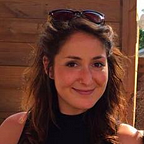Through a New Lens: VR and the Future of Storytelling
If you’ve been in the throes of a great book, you know how a well-crafted story can transport you to an entirely different time, place and perspective. It was the world of books that first sparked Filterati Allyssa Evans’s passion for immersive experiences; and today, leading a team of Virtual Reality researchers, she’s helping drive the next generation of captivating storytelling.
As a Program Manager for our client, one of the world’s leading VR product developers, Allyssa supports the advanced user research that’s helping unlock VR’s full potential. In this interview she discusses some of the biggest challenges shaping the VR/AR/MR space, the qualities that make a winning VR team, and why this immersive technology will function as a groundbreaking “empathy machine.”
Q: Why is user research such an important part of the VR/AR/MR product development process?
I think of VR as the new frontier for UX, and it requires a thoughtful, well-designed, and well-researched approach to how users will interact with this technology. I think that user research is crucial to ensuring that VR is a technology that people actually want to interact with.
We can look at mistakes in the past — such as ill-designed VR causing motion sickness — as evidence that user research is critical to determining an intuitive and desirable experience for all users. Being a part of a team that is working to collect important data on how people interact and react to this new technology is amazing, and only solidifies in my mind how crucial this research is in the VR design process.
Q: What are some of the medium-specific challenges facing today’s VR creators?
VR as a technology is still new, and because of that there are still a lot of limitations in terms of hardware and storage capacity among others. These limitations mean that artists have to be very aware of the restraints required when creating assets. This gives them new opportunities to think outside of the box when designing incredible assets that fall within those restraints.
Q: Aside from technical skills, what do you believe are the biggest keys to a successful VR team?
VR teams require individuals who are willing to take risks and find innovative solutions. As individuals and as a team, you need to be flexible, and ready to switch gears and rise to new challenges. This technology is so new, and advances are being made all the time. There is no preset way to do things, processes are being refined, and new methods are created every day. You also need to find creative individuals who approach storytelling with an open mind and new visions.
Q: What types of new VR/AR/MR experiences are you most excited to see being developed?
One of the areas that I’ve been very interested in recently is the use of VR to help people understand the world from another person’s perspective. There’s a lot of work being done right now on how VR can be used as an “empathy machine,” and I think that’s fascinating and exciting. A lot of conflict and lack of understanding in the world simply comes from the fact that we can’t walk a day in another person’s shoes. Virtual Reality artists and researchers around the world are working to break down those barriers through VR.
A great example of this is The Machine to Be Another, an art collective that is working to help participants see the world through another person’s eyes. Using VR to help grow our capacity for empathy is an important and vital use for this new technology. I think there is a huge opportunity to use VR to further connect us as humans, and to help people to intimately understand the world in a new way.
Q: How did you become interested in the VR space?
I’ve been interested in VR since I was a kid. I’ve always been a big reader and lover of immersive experiences, and have been fascinated by the idea of being immersed in a totally virtual world since the Star Trek Holodeck.
Although I started my project management career in IT, I quickly moved into a more creative industry, where I spend time as a Producer at a company working to develop immersive, interactive children’s books with a strong interest in creating AR/MR/VR content for kids. Once that project ended, I was presented with the opportunity to work with virtual reality researchers. It’s incredible to be a part of team focused on technologies that seem to be dropped in from the future.
Originally published at www.filterdigital.com.
